
The last few days were very interesting for absolutely everyone that is into quadcopters or RC drones that can be used for aerial photography and/or video recording as well. The reason for that was the official announcement of the GoPro Karma drone, a product that was long in the making and everybody had really high expectations from. With the Karma drone GoPro kind of did an extension of their action camera making something like a flying action camera in the form of a drone... as expected their focus was mainly on using the drone for taking photos and recording videos and as a means to sell some more of their GoPro action cameras as well...
Interestingly enough the announcement of the GoPro Karma drone pretty much coincided with the release of a very similar product from another company - DJI. I'm talking about the DJI Mavic Pro drone that is very much like what GoPro offers with their first drone. That was not to be so surprising considering the fact that DJI is trying to be the market leader in the drone segment and they already have pretty good experience and a lot of products, while for GoPro the Karma is their first drone. The idea of the DJI Mavic Pro is to offer pretty much what their larger drones like the Phantom series ones provide in terms of features and capabilities, but in a smaller and more compact model that folds up and does not take much space like the GoPro Karma. DJI being a drone company and not n action camera one has gone to a bit different approach with their new Mavic Pro drone even though it competes directly with the GoPro Karma in every aspect.
That is why I have decided to do a comparison between the key advantages and differences between the two drones and present that to you in hope to make it easy to decide which one might be the better solution for your needs. Frankly said I am still wondering which one will best for my needs as I was very excited with the announcement of the Karma drone and then even more excited by the release of the Mavic Pro. So I still haven't made my final decision and I'll most likely do it after seeing some more detailed user reviews and actual video footage from both drones that was not shot by professionals...
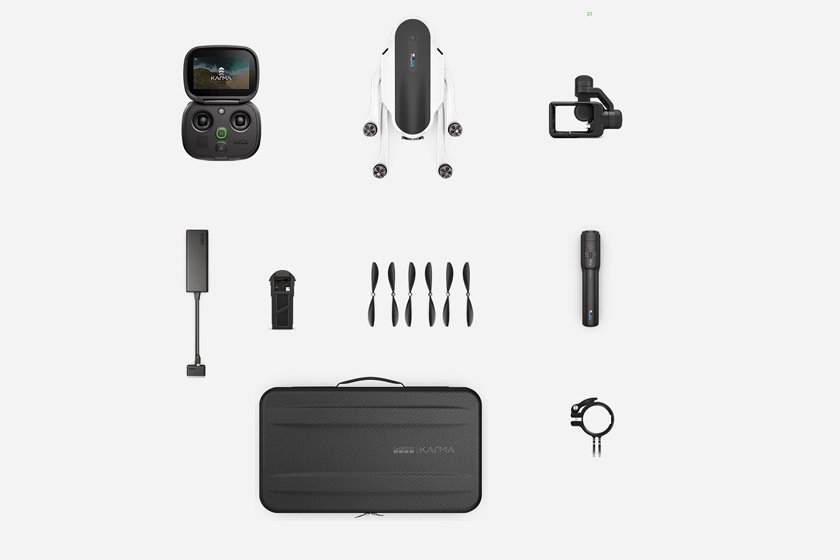
What You Get and Other Options
The GoPro Karma
The Karma drone comes with everything you need to get started apart from the GoPro camera - drone, battery, charger, remote controller, detachable gimbal and gimbal handle, and that will cost you $799.99 USD when the Karma is available on the market on October 23rd (according to the official website). So that it a month of waiting before you can get your hands on the drone in your hands and start using it.
You will need to get a GoPro HERO5 Black, HERO5 Session or a HERO4 Black/Silver action camera that can be used along with the Karma drone in order to be able to shoot video and photos. The HERO4 Black/Silver compatibility means that you might already have a very good GoPro camera that you can use with the Karma drone or be able to get a cheaper used one to use. The new HERO5 Black however offers better image quality and nice extra features, but it will also cost you $399.99 USD when it becomes available on the market on October 2nd or in just a few days.
What it turns out is that getting a GoPro Karma drone with a GoPro HERO5 Black action camera will end up costing you $1199.98 USD in order for you to be able to get the best possible photo and video quality from the device. Since the transmitter is already included and it has its own screen there is no need to add something like a smartphone in the calculation as well like you would need for the DJI for example. The nice bonus that GoPro offers is the detachable gimbal that you can remove from the drone and attach to the special handle and you get a handheld stabilized video recording solution that you can use to get some more on the ground recordings.
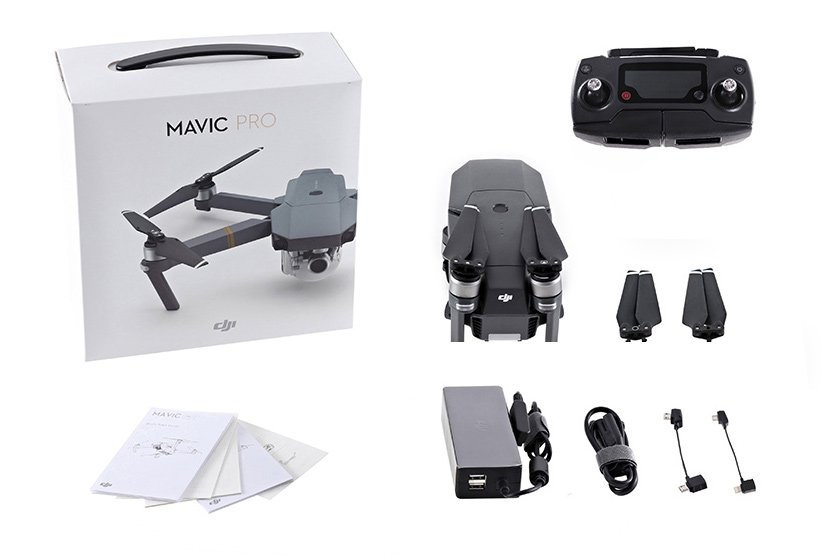
The DJI Mavic Pro
The Mavic Pro does come with everything you need to get started with apart from the smartphone that you will need to connect to your remote controller and the whole package costs $999 USD. This is a bit more expensive than the base price of the GoPro Karma, however here you don't need to buy an extra camera or already have one available, the camera is a part of the drone already. You still need to have a compatible smartphone with Android or iOS operating system to use as a display and to have the control and monitoring software installed on it, the good thing here is that you most likely already have that covered, so no extra cost should be added. Even if you don't have the best phone for use with the Mavic Pro you can still purchase a pretty decent device without having to go for a top model that can cost close to as much as the whole drone for example. Then again having a decent smartphone already is something that most people already do have covered as it is much more common thing than having a GoPro action camera.
Now, since DJI is not a camera company, but a drone company they are also going to be offering DJI Goggles that will allow you to fly the Mavic Pro in FPV mode instead of looking at the video feed on your smartphone. This pretty much extends the base functionality and adds a whole different level of fun, but it is also moving away from the idea of using the drone as a photo or video camera only. The video Goggles are optional and you need to purchase them separately should you decide that you need them as probably not everyone does and will be using them... FPV flying is a different experience, but one not for everyone as well.
What the Mavic Pro does not offer is a detachable gimbal and camera that you can use to shoot video with the camera of the drone on the ground like you can with the GoPro Karma drone for example. This is the major difference between the basic functionality of the two drones. Then again considering the small form factor of the DJI Mavic Pro you might still be able to use the whole drone as a sort of hand-held gimbal to record video as well, though not as convenient with a dedicated handle for that.
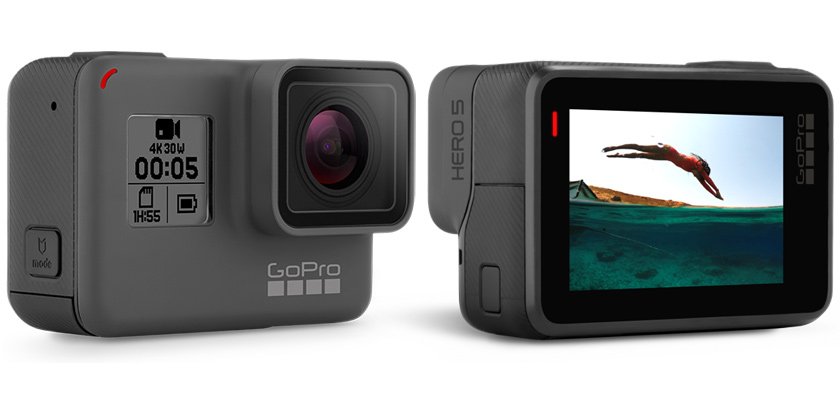
The Camera, Photo and Video Quality and Features
Now, while both drones come with a 4K capable video camera that can record high-quality videos and take 12 Megapixel still photos there are some differences. With GoPro being in the action camera business for a long time already and passing through a multiple generation of products they simply have more experience and user feedback. So the new GoPro Hero5 action camera does seem more impressive in terms of capabilities and specifications as well as extra features available. I kind of expect that it will be able to provide a bit better results if you get it tweaked a bit and use the right mode.
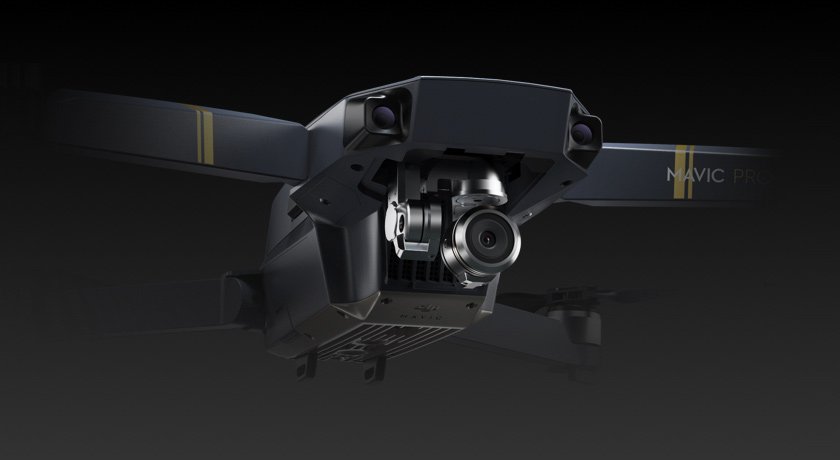
On the other hand the smaller and simpler looking camera from DJI is also surprisingly good considering that this is not the company's core business. What DJI have done is to provide a ready good image quality in a compact size and features that are easy to control over the remote link to the drone giving you more direct wireless control of the camera. The image quality is really good, though may not be as good as on the new Hero5 it is still more than enough for non-professional use and maybe even for some professional as well. Since the DJI camera has been designed with drone use in mind and not to also be a more general action camera like the new Hero5 it is easier to be used by not so advanced users.
Since both of these drones do center a lot on being able to give you the right tools for shooting great aerial photos and videos they do come with very good stabilization of the cameras as well as some extra features to allow you to make the best of what you have available. The list of specific filming features is different on both drones and as one would expect GoPro apparently went on trying to provide features that would make for better cinematic shots while DJI went for making the drone more useful for regular person. The DJI Mavic Pro is packed with more sensors and should be able to provide a really good mode for tracking objects and recording video of them automatically without the need for the user to constantly monitor and control it. These extra functionalities need to be further explored of course and considered what is more useful for who and what works better.
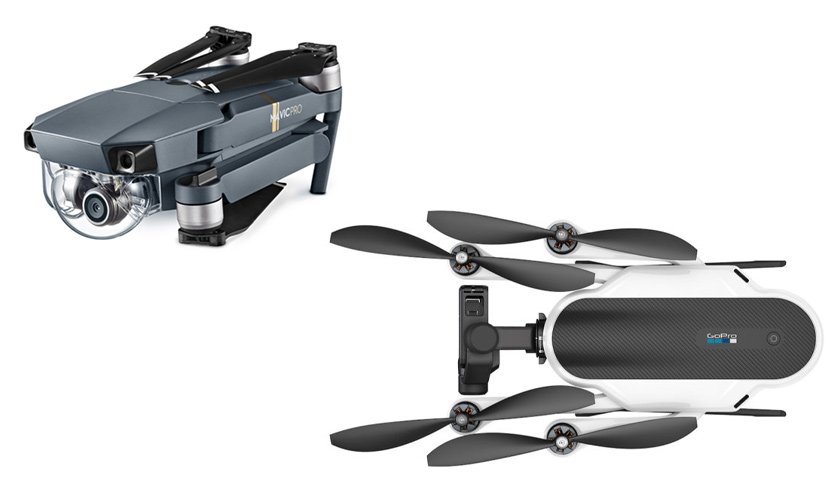
The Size of the Drone
Both the GoPro Karma and the DJI Mavic Pro are pretty compact in size and they are foldable, meaning that that get even smaller when in transportation, even their controllers are pretty small as well. So they will not be taking up too much space in your backpack or luggage when traveling around with them ready to take them out and do some nice video or just take some aerial photos with them. In terms of actual size the Mavic Pro does seem to be a bit more compact in size and also weights less, so if space and weight is really an issue the DJI does a bit better here.
The size of the controller is also smaller in the case of the DJI's drone, one thing that helps for that is the fact that the Karma drone comes with a full blown controller with display and everything, while the Mavic Pro relies on your smartphone for the display part. Both controllers are still pretty compact in size and in terms of weight, but DJI does better here as well as you would most likely keep you smartphone in our pocket or bag anyway.
It seems here the clear winner is the DJI Mavic Pro drone, though the differences in weight and size are not that big and the GoPro Karma drone is still a pretty compact solution as well, though not as compact and lightweight apparently.
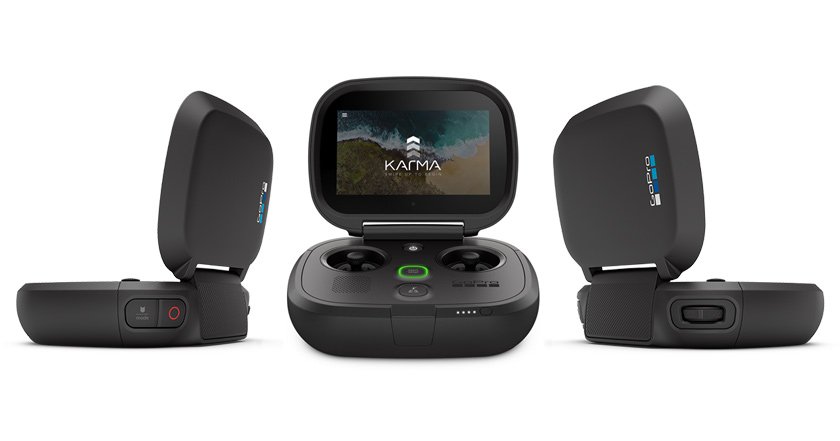
The Drone Controller
The controller of the Karma drone does look like a portable game console as it folds up and has a screen on top, the display is a 5-inch touch one with a 720p resolution and very high brightness, making it ideal for use outdoors. The most significant advantage specification wise is probably the fact that the display is rated at 900 nits (cd/m2) maximum brightness and that should make it easier to read and use when you fly the drone on a bright sunny day. The battery life of the controller is stated at 4 hours according to the official specifications, so good job on that as well. It seems that GoPro did spend quite some time on actually designing the RC transmitter to make it easy to use and functional in different conditions.
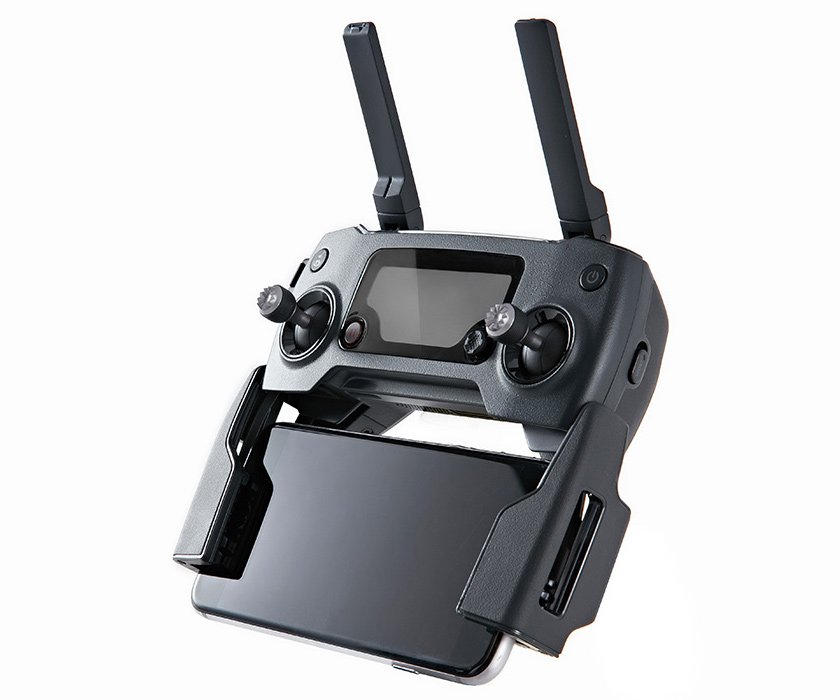
The controller of the Mavic Pro looks simplified and does not come with a display, instead you plug in your smaprtphone and use it to extend the very basic functionality of the controller and have a display. It also looks a lot like a portable game console when you put your smartphone inside and get to as a screen to display the drone software and video feed you are getting form it. There RC transmitter should be capable of providing about 3 hours of usage time, though that goes only for the transmitter and since you use a phone as well you need to mind the battery of the smaprtphone as well. Unfortunately not that many smartphones come with as bright displays as what the GoPro Karma's screen is apparently capable of as a maximum brightness, so bright sunny days may be causing you some issues with the image displayed on the phone's screen.
While the two drone's transmitters are a bit different from each other in design, their basic concept is pretty much the same. They seem to do well in terms of usability and convenience as well as ease of use by not so advanced pilots, they need to be easy for use from pretty much anyone by design. The most significant difference is in the software and functionality it offers for remote control of the drone's functionality as well as in the even more important specification - transmission range. I'll be talking more about the range in a bit as it needs more focus.
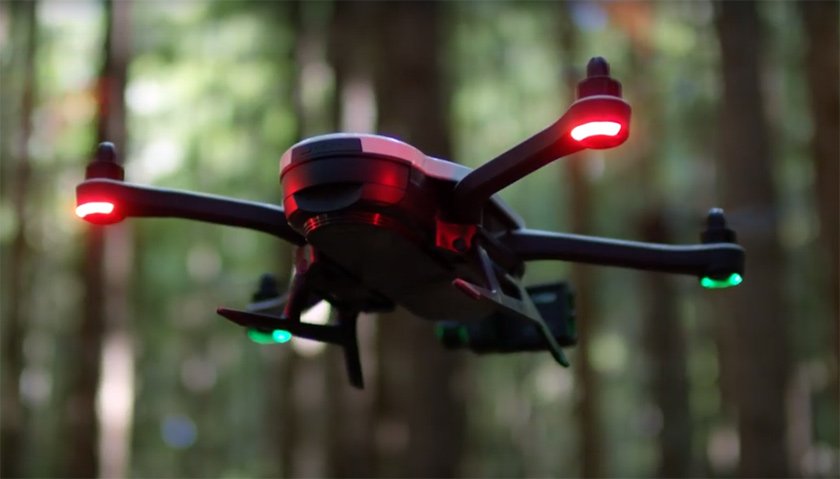
Maximum Speed and Flight Time On a Single Charge
According to the official specifications the GoPro Karma drone is capable of up to 35 mph (15 m/s) or about 56 km/h, but that maximum speed is probably when flying in ideal conditions with zero wind. The maximum speed of the DJI Mavic Pro is a bit higher at 40 mph (65 kph) in Sport mode and without wind, so not that much of a difference as you rarely find the ideal conditions to fly in anyway.
With drones the maximum flight speed is just one of the important factors, it is important if you want to move further away from the point you take off from, then shoot something and get back. Being able to fly fast and get back fast really gives you more time to spend on taking photos or shooting video of the thing you want to. What you need to also have however is fast ascending and descending speeds of the drone, so you can save flight time from that as well and DJI already does do that pretty quickly. Unfortunately there are no specifications for the ascend/descend speeds of the GoPro Karma drone available, so it might be slower as well like in terms of the maximum speed as well.
What about the flight time you get with a single charge of the battery? The DJI Mavic Pro uses 3830mAh, 11.4V 3S LiPo battery that is capable of delivering a maximum flight time of up to 27 minutes at 0 wind and with a consistent 15.5 mph (25 kpm/h) flying speed... that is like a lab only ideal conditions, so normally you should expect a bit less in actual use. DJI says that their new drone is capable of 24 minutes hover time with zero wind and an overall safe flight time of about 21 minutes with 15% remaining battery level to be on the safe side.
The GoPro Karma drone uses a larger 5100mAh, 14.8V 4S LiPo battery that is apparently capable of delivering up to 20 minutes of flight time according to the official specifications. GoPro does not go into much details about the conditions it tested the battery life, but you can pretty much assume that in actual flying conditions 20 minutes will not be very easy to achieve, especially if you want to be on the safe side and land the drone before the battery gets fully depleted.
The fact that the DJI drone is smaller and lighter apparently does affect the flight time you get, because of that the Mavic Pro also saves on the battery capacity and weight and still manages to get a better flight time... at least on paper.
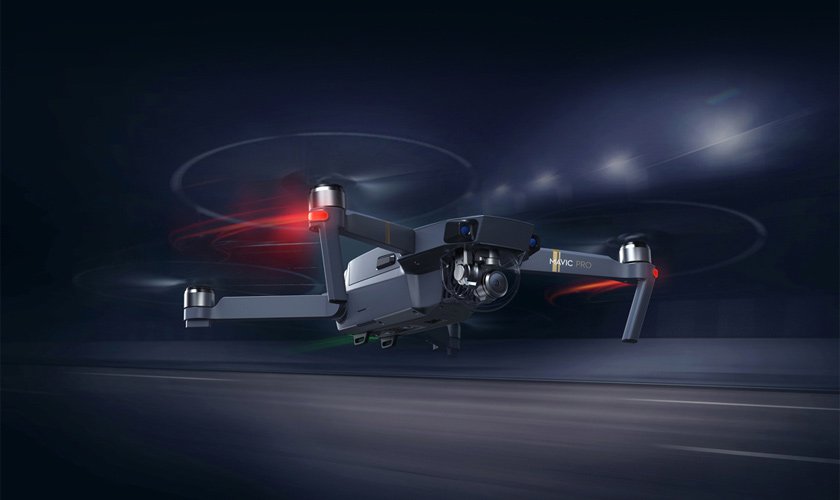
Operating and Video Range
This is where the DJI Mavic Pro really does shine at least according to the official specifications that the company has listed. I know from experience with their Phantom drones mostly that DJI is already ahead from the competition a lot in terms of digital video connection between the drone and the transmitter. They are offering really high flying ranges and video link ranges and at the same time manage to keep the drone responsive and the video quality high. DJI has taken that even a step further in their new Mavic Pro drone apparently as they have extended the official maximum connection range even further than what their latest Phantom 4 was officially capable of. The new Mavic Pro should be capable of maximum transmission rage of up to 4.3 miles or 7 kilometers and that is really a lot for a drone that is rated at maximum flight distance of about 8 miles. Essentially you should be able to fly 4 miles away from you to keep in the radio range and get back to the start point on a single charge and without losing connection with the drone.
Unfortunately there is a bit of a catch with the DJI Mavic Pro drone that is related to the maximum range that you can get. Due to different regulations of the maximum safe radio transmission power the range is different in different regions of the world. You only get 4.3 miles or 7 kilometers of range in US while because of stricter European regulations in Europe the range is reduced to just about 2.5 miles or about 4 kilometers (the radio is in lower power mode). Even at the reduced radio power and lower transmission rage the DJI does really great, or at least based on the official specifications that the company is citing.
As a comparison the GoPro Karma does not do very well with its much smaller range of just about 0.62 miles or about 1 kilometer. This is a serious limitation for people that want to have more freedom and be able to take the drone further away from them, much further than the point that they will not be able to see it with their bare eyes anymore. DJI is really shining here and is showing its significant advantage that is available not only over the first GoPro drone, but pretty much what any of its competitors offer in terms of maximum transmission range.
Now, If we look from a different perspective you would most likely still going to be using either of these two drones mostly for close flights where they will be shooting you or something else nearby. Still, if you decide to take it further away it would be nice to have the option for a larger range and it will probably take some time for GoPro to catch up to the extended range that DJI has been offering for a while already on their products. Again, GoPro is still really new to drones and this is the core business of DJI and they have much more focus and experience in that area alone.

Introductory Video of the GoPro Karma Drone

Introductory Video of the DJI Mavic Pro Drone
I still haven't decided yet, but the more I weight things for the moment, the more the balance moves towards the DJI Mavic Pro drone instead of the GoPro one... even though I already have a GoPro action camera that will be compatible with the Karma drone.
What is your opinion, which of the two compact camera drones you like more and why?
If you have a question or want to add something, then please leave a comment below.
Did you like what you have just read? Check my other posts on steemit @cryptos
If you like what I'm doing for Steem and on Steemit you can support me as a Witness
